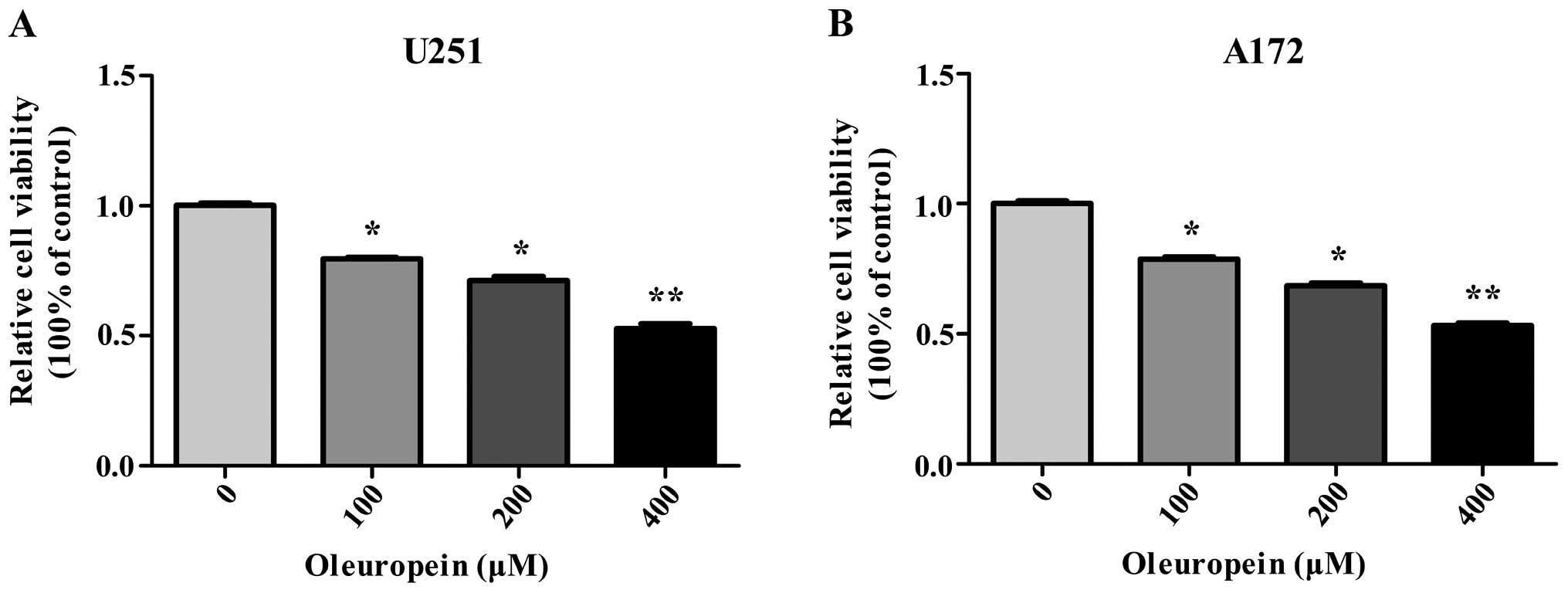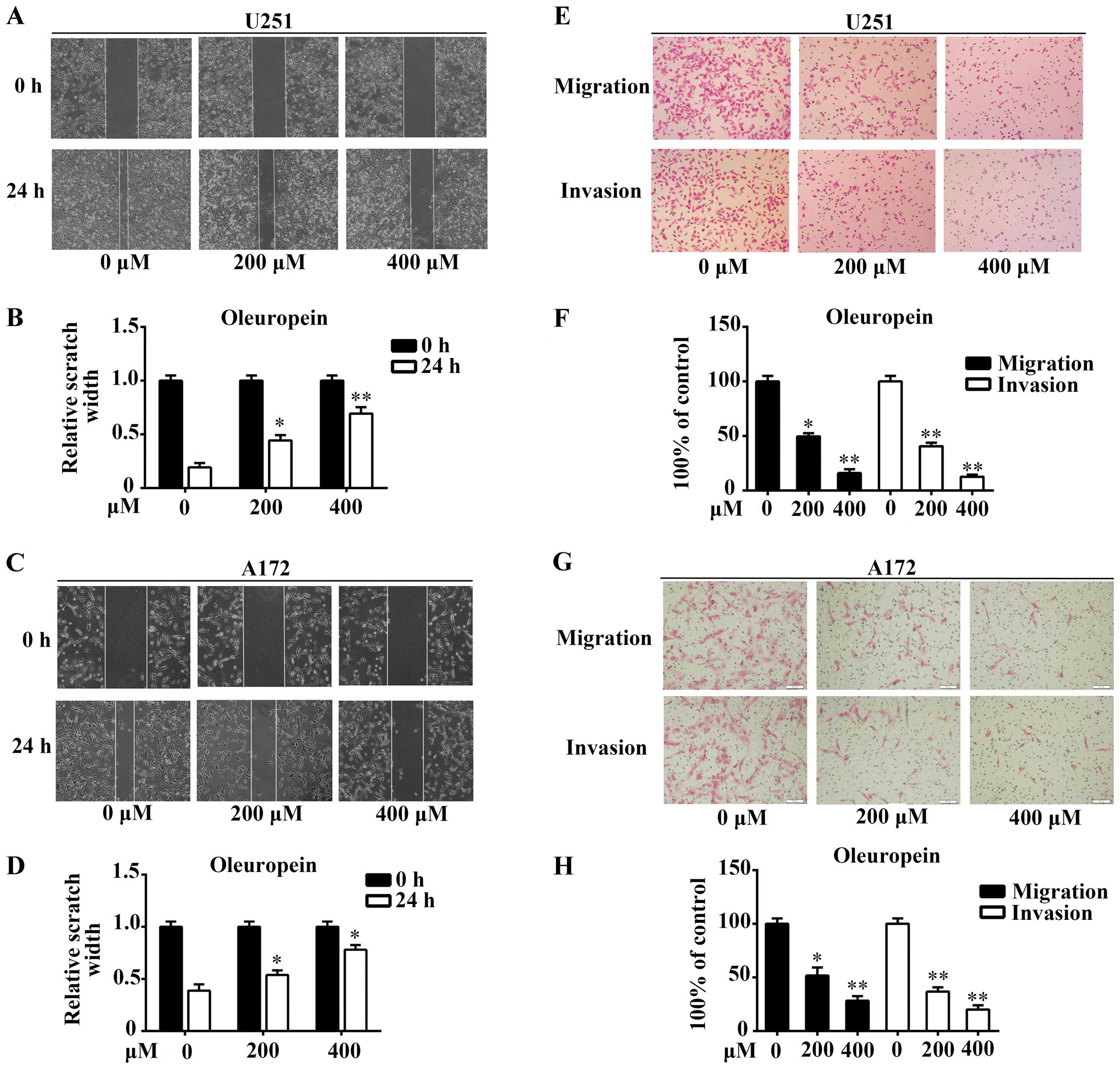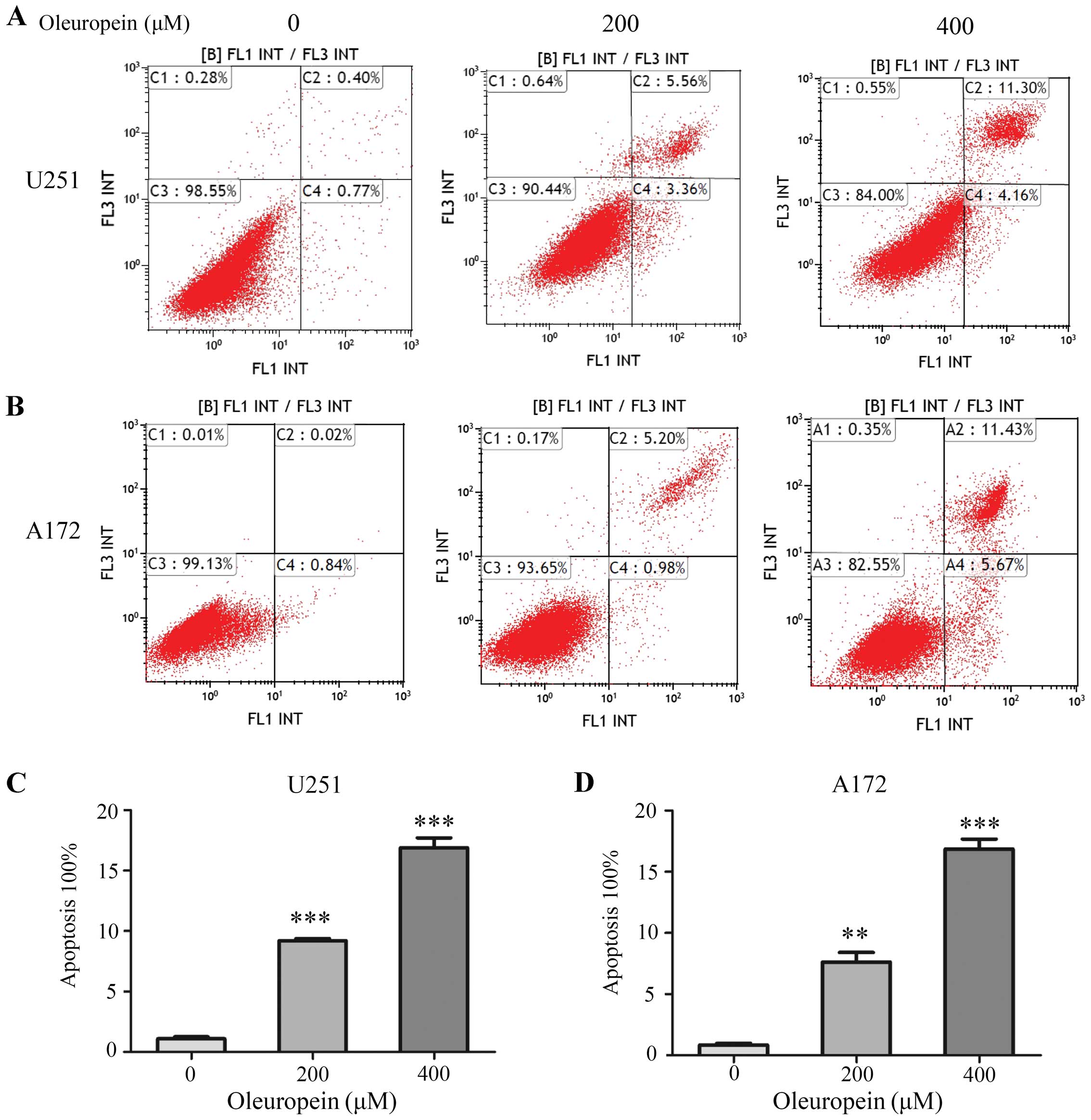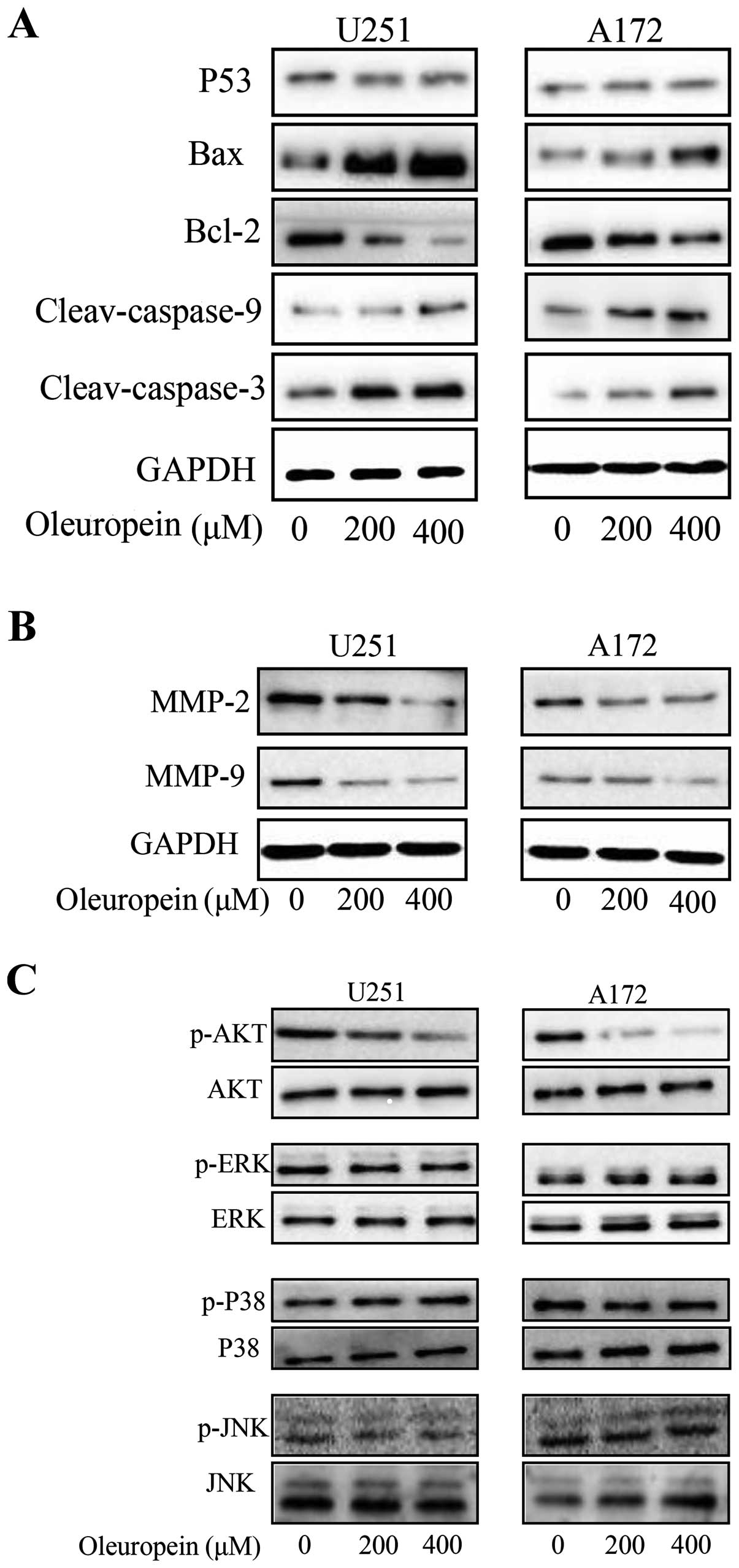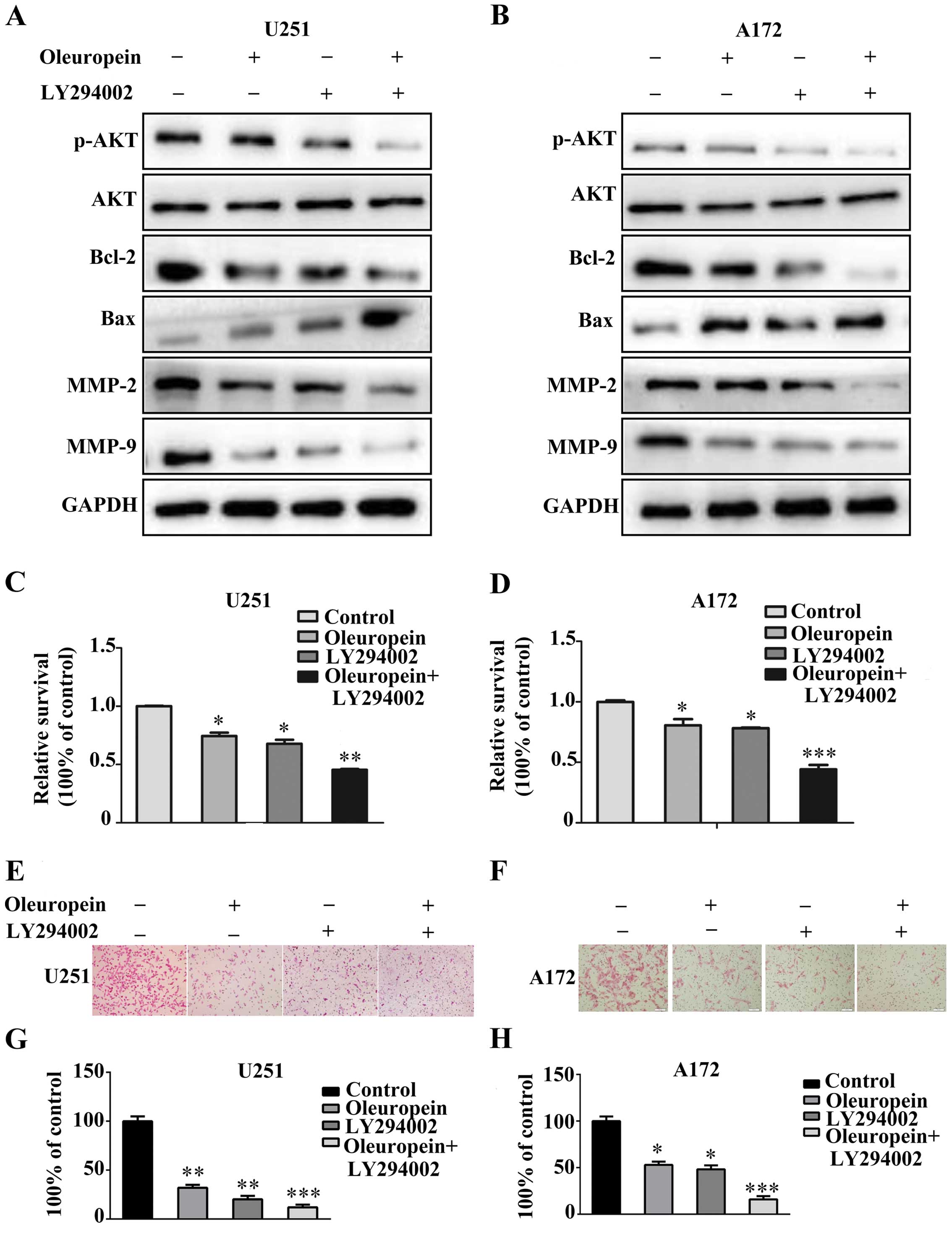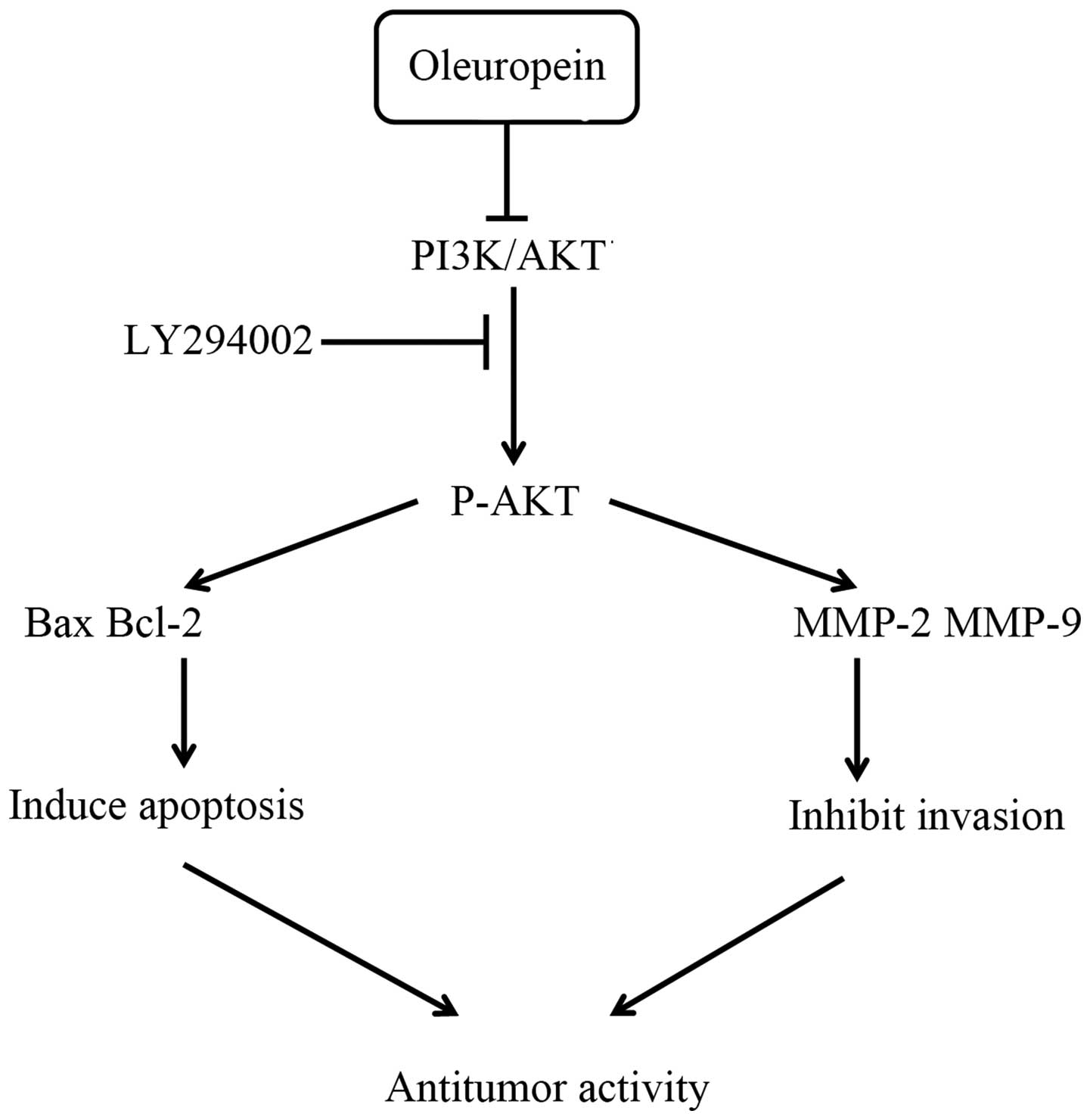|
1
|
Fisher PG and Buffler PA: Malignant
gliomas in 2005: Where to GO from here? JAMA. 293:615–617. 2005.
View Article : Google Scholar : PubMed/NCBI
|
|
2
|
Ricard D, Idbaih A, Ducray F, Lahutte M,
Hoang-Xuan K and Delattre JY: Primary brain tumours in adults.
Lancet. 379:1984–1996. 2012. View Article : Google Scholar : PubMed/NCBI
|
|
3
|
Rock K, McArdle O, Forde P, Dunne M,
Fitzpatrick D, O'Neill B and Faul C: A clinical review of treatment
outcomes in glioblastoma multiforme - the validation in a non-trial
population of the results of a randomised Phase III clinical trial:
Has a more radical approach improved survival. Br J Radiol.
85:729–733. 2012. View Article : Google Scholar
|
|
4
|
Coni E, Di Benedetto R, Di Pasquale M,
Masella R, Modesti D, Mattei R and Carlini EA: Protective effect of
oleuropein, an olive oil biophenol, on low density lipoprotein
oxidizability in rabbits. Lipids. 35:45–54. 2000. View Article : Google Scholar : PubMed/NCBI
|
|
5
|
Visioli F, Caruso D, Galli C, Viappiani S,
Galli G and Sala A: Olive oils rich in natural catecholic phenols
decrease isoprostane excretion in humans. Biochem Biophys Res
Commun. 278:797–799. 2000. View Article : Google Scholar : PubMed/NCBI
|
|
6
|
Aziz NH, Farag SE, Mousa LA and Abo-Zaid
MA: Comparative antibacterial and antifungal effects of some
phenolic compounds. Microbios. 93:43–54. 1998.PubMed/NCBI
|
|
7
|
Bisignano G, Tomaino A, Lo Cascio R,
Crisafi G, Uccella N and Saija A: On the in-vitro antimicrobial
activity of oleuropein and hydroxytyrosol. J Pharm Pharmacol.
51:971–974. 1999. View Article : Google Scholar : PubMed/NCBI
|
|
8
|
Micol V, Caturla N, Pérez-Fons L, Más V,
Pérez L and Estepa A: The olive leaf extract exhibits antiviral
activity against viral haemorrhagic septicaemia rhabdovirus (VHSV).
Antiviral Res. 66:129–136. 2005. View Article : Google Scholar : PubMed/NCBI
|
|
9
|
Lee-Huang S, Zhang L and Huang PL, Chang
YT and Huang PL: Anti-HIV activity of olive leaf extract (OLE) and
modulation of host cell gene expression by HIV-1 infection and OLE
treatment. Biochem Biophys Res Commun. 307:1029–1037. 2003.
View Article : Google Scholar : PubMed/NCBI
|
|
10
|
Bazoti FN, Bergquist J, Markides KE and
Tsarbopoulos A: Noncovalent interaction between
amyloid-beta-peptide (1–40) and oleuropein studied by electrospray
ionization mass spectrometry. J Am Soc Mass Spectrom. 17:568–575.
2006. View Article : Google Scholar : PubMed/NCBI
|
|
11
|
Mijatovic SA, Timotijevic GS, Miljkovic
DM, Radovic JM, Maksimovic-Ivanic DD, Dekanski DP and
Stosic-Grujicic SD: Multiple antimelanoma potential of dry olive
leaf extract. Int J Cancer. 128:1955–1965. 2011. View Article : Google Scholar
|
|
12
|
Fares R, Bazzi S, Baydoun SE and
Abdel-Massih RM: The antioxidant and anti-proliferative activity of
the Lebanese Olea europaea extract. Plant Foods Hum Nutr. 66:58–63.
2011. View Article : Google Scholar : PubMed/NCBI
|
|
13
|
Corona G, Deiana M, Incani A, Vauzour D,
Dessì MA and Spencer JP: Inhibition of p38/CREB phosphorylation and
COX-2 expression by olive oil polyphenols underlies their
anti-proliferative effects. Biochem Biophys Res Commun.
362:606–611. 2007. View Article : Google Scholar : PubMed/NCBI
|
|
14
|
Han J, Talorete TP, Yamada P and Isoda H:
Anti-proliferative and apoptotic effects of oleuropein and
hydroxytyrosol on human breast cancer MCF-7 cells. Cytotechnology.
59:45–53. 2009. View Article : Google Scholar : PubMed/NCBI
|
|
15
|
Acquaviva R, Di Giacomo C, Sorrenti V,
Galvano F, Santangelo R, Cardile V, Gangia S, D'Orazio N, Abraham
NG and Vanella L: Antiproliferative effect of oleuropein in
prostate cell lines. Int J Oncol. 41:31–38. 2012.PubMed/NCBI
|
|
16
|
Chan SL and Yu VC: Proteins of the bcl-2
family in apoptosis signalling: From mechanistic insights to
therapeutic opportunities. Clin Exp Pharmacol Physiol. 31:119–128.
2004. View Article : Google Scholar : PubMed/NCBI
|
|
17
|
Nakano A, Tani E, Miyazaki K, Yamamoto Y
and Furuyama J: Matrix metalloproteinases and tissue inhibitors of
metallopro-teinases in human gliomas. J Neurosurg. 83:298–307.
1995. View Article : Google Scholar : PubMed/NCBI
|
|
18
|
Oltvai ZN, Milliman CL and Korsmeyer SJ:
Bcl-2 heterodimerizes in vivo with a conserved homolog, Bax, that
accelerates programmed cell death. Cell. 74:609–619. 1993.
View Article : Google Scholar : PubMed/NCBI
|
|
19
|
Marzo I, Brenner C, Zamzami N,
Jürgensmeier JM, Susin SA, Vieira HL, Prévost MC, Xie Z, Matsuyama
S, Reed JC, et al: Bax and adenine nucleotide translocator
cooperate in the mitochondrial control of apoptosis. Science.
281:2027–2031. 1998. View Article : Google Scholar : PubMed/NCBI
|
|
20
|
Gialeli C, Theocharis AD and Karamanos NK:
Roles of matrix metalloproteinases in cancer progression and their
pharmacological targeting. FEBS J. 278:16–27. 2011. View Article : Google Scholar
|
|
21
|
Kettenmann H, Hanisch UK, Noda M and
Verkhratsky A: Physiology of microglia. Physiol Rev. 91:461–553.
2011. View Article : Google Scholar : PubMed/NCBI
|
|
22
|
Opferman JT and Korsmeyer SJ: Apoptosis in
the development and maintenance of the immune system. Nat Immunol.
4:410–415. 2003. View Article : Google Scholar : PubMed/NCBI
|
|
23
|
Vaux DL, Cory S and Adams JM: Bcl-2 gene
promotes haemopoietic cell survival and cooperates with c-myc to
immortalize pre-B cells. Nature. 335:440–442. 1988. View Article : Google Scholar : PubMed/NCBI
|
|
24
|
Strasser A, Harris AW, Bath ML and Cory S:
Novel primitive lymphoid tumours induced in transgenic mice by
cooperation between myc and bcl-2. Nature. 348:331–333. 1990.
View Article : Google Scholar : PubMed/NCBI
|
|
25
|
Yang J, Liu X, Bhalla K, Kim CN, Ibrado
AM, Cai J, Peng TI, Jones DP and Wang X: Prevention of apoptosis by
Bcl-2: Release of cytochrome c from mitochondria blocked. Science.
275:1129–1132. 1997. View Article : Google Scholar : PubMed/NCBI
|
|
26
|
Danial NN: BCL-2 family proteins: Critical
checkpoints of apoptotic cell death. Clin Cancer Res. 13:7254–7263.
2007. View Article : Google Scholar : PubMed/NCBI
|
|
27
|
Susin SA, Lorenzo HK, Zamzami N, Marzo I,
Snow BE, Brothers GM, Mangion J, Jacotot E, Costantini P, Loeffler
M, et al: Molecular characterization of mitochondrial
apoptosis-inducing factor. Nature. 397:441–446. 1999. View Article : Google Scholar : PubMed/NCBI
|
|
28
|
Du C, Fang M, Li Y, Li L and Wang X: Smac,
a mitochondrial protein that promotes cytochrome c-dependent
caspase activation by eliminating IAP inhibition. Cell. 102:33–42.
2000. View Article : Google Scholar : PubMed/NCBI
|
|
29
|
Verhagen AM, Ekert PG, Pakusch M, Silke J,
Connolly LM, Reid GE, Moritz RL, Simpson RJ and Vaux DL:
Identification of DIABLO, a mammalian protein that promotes
apoptosis by binding to and antagonizing IAP proteins. Cell.
102:43–53. 2000. View Article : Google Scholar : PubMed/NCBI
|
|
30
|
Li LY, Luo X and Wang X: Endonuclease G is
an apoptotic DNase when released from mitochondria. Nature.
412:95–99. 2001. View
Article : Google Scholar : PubMed/NCBI
|
|
31
|
Baffy G, Miyashita T, Williamson JR and
Reed JC: Apoptosis induced by withdrawal of interleukin-3 (IL-3)
from an IL-3-dependent hematopoietic cell line is associated with
repartitioning of intracellular calcium and is blocked by enforced
Bcl-2 oncoprotein production. J Biol Chem. 268:6511–6519.
1993.PubMed/NCBI
|
|
32
|
Hennet T, Bertoni G, Richter C and
Peterhans E: Expression of BCL-2 protein enhances the survival of
mouse fibrosarcoid cells in tumor necrosis factor-mediated
cytotoxicity. Cancer Res. 53:1456–1460. 1993.PubMed/NCBI
|
|
33
|
Lam M, Dubyak G, Chen L, Nuñez G, Miesfeld
RL and Distelhorst CW: Evidence that BCL-2 represses apoptosis by
regulating endoplasmic reticulum-associated Ca2+ fluxes.
Proc Natl Acad Sci USA. 91:6569–6573. 1994. View Article : Google Scholar
|
|
34
|
Zhang N, Wang X, Huo Q, Li X, Wang H,
Schneider P, Hu G and Yang Q: The oncogene metadherin modulates the
apoptotic pathway based on the tumor necrosis factor superfamily
member TRAIL (tumor necrosis factor-related apoptosis-inducing
ligand) in breast cancer. J Biol Chem. 288:9396–9407. 2013.
View Article : Google Scholar : PubMed/NCBI
|
|
35
|
Crompton M: Bax, Bid and the
permeabilization of the mitochondrial outer membrane in apoptosis.
Curr Opin Cell Biol. 12:414–419. 2000. View Article : Google Scholar : PubMed/NCBI
|
|
36
|
Habibović S, Hrgović Z, Bukvić I and
Hrgović I: Molecular mechanisms in apoptosis. Med Arh. 54:33–40.
2000.In Croatian.
|
|
37
|
Antonsson B: Bax and other pro-apoptotic
Bcl-2 family 'killer-proteins' and their victim the mitochondrion.
Cell Tissue Res. 306:347–361. 2001. View Article : Google Scholar : PubMed/NCBI
|
|
38
|
Himelstein BP, Lee EJ, Sato H, Seiki M and
Muschel RJ: Tumor cell contact mediated transcriptional activation
of the fibroblast matrix metalloproteinase-9 gene: Involvement of
multiple transcription factors including Ets and an alternating
purine-pyrimidine repeat. Clin Exp Metastasis. 16:169–177. 1998.
View Article : Google Scholar : PubMed/NCBI
|
|
39
|
Hu Y and Ivashkiv LB: Costimulation of
chemokine receptor signaling by matrix metalloproteinase-9 mediates
enhanced migration of IFN-alpha dendritic cells. J Immunol.
176:6022–6033. 2006. View Article : Google Scholar : PubMed/NCBI
|
|
40
|
Kallakury BV, Karikehalli S, Haholu A,
Sheehan CE, Azumi N and Ross JS: Increased expression of matrix
metalloproteinases 2 and 9 and tissue inhibitors of
metalloproteinases 1 and 2 correlate with poor prognostic variables
in renal cell carcinoma. Clin Cancer Res. 7:3113–3119.
2001.PubMed/NCBI
|
|
41
|
Wang F, Zhang P, Yang L, Yu X, Ye X, Yang
J, Qian C, Zhang X, Cui YH and Bian XW: Activation of toll-like
receptor 2 promotes invasion by upregulating MMPs in glioma stem
cells. Am J Transl Res. 7:607–615. 2015.PubMed/NCBI
|
|
42
|
Zhang Z, Lv J, Lei X, Li S, Zhang Y, Meng
L, Xue R and Li Z: Baicalein reduces the invasion of glioma cells
via reducing the activity of p38 signaling pathway. PLoS One.
9:e903182014. View Article : Google Scholar : PubMed/NCBI
|
|
43
|
Fresno Vara JA, Casado E, de Castro J,
Cejas P, Belda-Iniesta C and González-Barón M: PI3K/Akt signalling
pathway and cancer. Cancer Treat Rev. 30:193–204. 2004. View Article : Google Scholar : PubMed/NCBI
|
|
44
|
Fang Z, Tang Y, Jiao W, Xing Z, Guo Z,
Wang W, Shi B, Xu Z and Liu Z: Nitidine chloride inhibits renal
cancer cell metastasis via suppressing AKT signaling pathway. Food
Chem Toxicol. 60:246–251. 2013. View Article : Google Scholar : PubMed/NCBI
|
|
45
|
Vier J, Groth M, Sochalska M and Kirschnek
S: The anti-apoptotic Bcl-2 family protein A1/Bfl-1 regulates
neutrophil survival and homeostasis and is controlled via PI3K and
JAK/STAT signaling. Cell Death Dis. 7:e21032016. View Article : Google Scholar : PubMed/NCBI
|
|
46
|
Morgensztern D and McLeod HL:
PI3K/Akt/mTOR pathway as a target for cancer therapy. Anticancer
Drugs. 16:797–803. 2005. View Article : Google Scholar : PubMed/NCBI
|
|
47
|
Carrera-González MP, Ramírez-Expósito MJ,
Mayas MD and Martínez-Martos JM: Protective role of oleuropein and
its metabolite hydroxytyrosol on cancer. Trends Food Sci Technol.
31:92–99. 2013. View Article : Google Scholar
|



